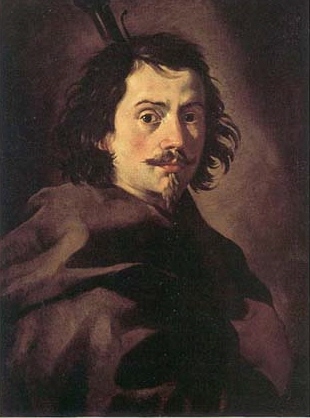
Francesco Borromini, byname of Francesco Castelli, was an Italian architect born in the modern Swiss canton of Ticino who, with his contemporaries Gian Lorenzo Bernini and Pietro da Cortona, was a leading figure in the emergence of Roman Baroque architecture.

The Confederation of Oratories of Saint Philip Neri, abbreviated C.O. and commonly known as the Oratorians, is a Catholic society of apostolic life of pontifical right for men who live together in a community bound together by no formal vows but only with the bond of charity.

Saints Firmus and Rusticus are venerated as two martyrs of Verona. Their unreliable Acts state that Firmus and Rusticus, kinsmen, were prominent citizens of Bergamo. They were martyred at Verona under the Emperor Maximian after refusing to sacrifice to pagan idols. Under the judge Anolinus, they were tortured, beaten with clubs, and beheaded.

Mogliano is a comune (municipality) in the Province of Macerata in the Italian region Marche, located about 50 kilometres (31 mi) south of Ancona and about 13 kilometres (8 mi) south of Macerata.
Giuseppe Bianchini was an Italian Oratorian, biblical, historical, and liturgical scholar. Clement XII and Benedict XIV, who highly appreciated his learning, entrusted him with several scientific labors. Bianchini had contemplated a large work on the texts of the Bible, Vindiciæ Canonicarum Scripturarum Vulgatæ latinæ editionis, which was to comprise several volumes, but only the first, in which, among other things, are to be found fragments of the Hexapla, was published. Much more important is his Evangeliarium quadruplex latinæ versionis antiquæ, etc., 2 vols.. Among his historical works may be mentioned the fourth volume which Bianchini added to the publication of his uncle, Francesco Bianchini, Anastasii bibliothecarii Vitæ Rom. Pontif. ; he also published the Demonstratio historiæ ecclesiasticæ quadripartitæ. The chief liturgical work of Bianchini is Liturgia antiqua hispanica, gothica, isidoriana, mozarabica, toletana mixta. He also undertook the edition of the works of B. Thomasius (Tomasi), but only one volume was issued.

The chiesa di Sant'Anastasia, or the Basilica of Saint Anastasia is a church built by the Dominican Order in Verona, northern Italy. In Gothic style, it is the largest church in the city, located in its most ancient district, near the Ponte Pietra.
Tommaso Dossi was an Italian painter of the late-Baroque period, active in Verona. He trained with Giovanni Murari and then with Simone Brentana. He painted an altarpiece of the Virgin and child with San Filippo Neri for the church of the Padre Filippini. He painted a Santa Eurosia for the parish church of Mazzurega.

San Fermo Maggiore is a Romanesque and Gothic church in central Verona. It is dedicated to Saints Firmus and Rusticus, brothers who are local martyrs from the 3rd century.

Veronese bell ringing is a style of ringing church bells that developed around Verona, Italy, from the eighteenth century. The bells are rung full circle, being held up by a rope and wheel until a note is required.

The Oratory of San Filippo Neri in Bologna is a restored late-Baroque religious structure in central Bologna. It is located on Via Manzoni. The Oratory was constructed from the sacristy of the adjacent church of the Madonna di Galliera. This church is now called Chiesa dei Filippini Madonna di Galliera e Filippo Neri.
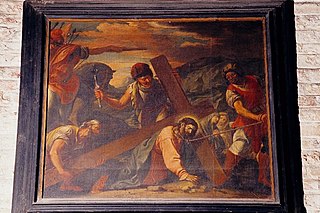
Lodovico Buffetti was an Italian painter.
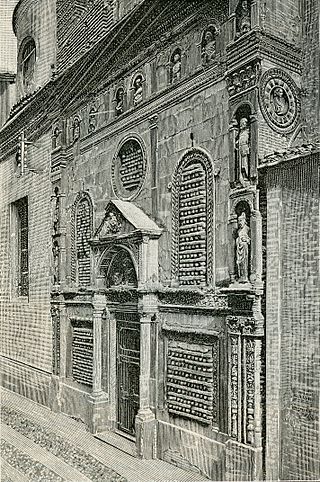
The Madonna di Galliera is a church with a Renaissance facade and Baroque interiors, located on Via Manzoni, in central Bologna, Italy. It stands in front of the Palazzo Ghisilardi Fava. The present name over the portal is the Chiesa di Filippini Madonna di Galliera e Filippo Neri.
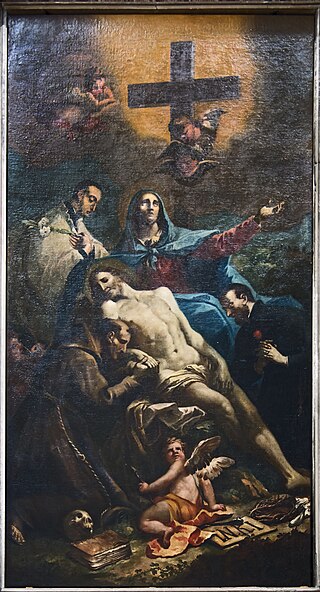
Agostino Ugolini was an Italian painter, active in a late-Baroque and early-neoclassic style.
Giovanni Battista Belloti was an Italian painter of the Baroque style, active mainly in Verona.
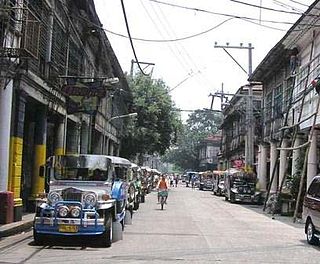
Hidalgo Street is a street located in Quiapo in the old downtown of Manila, Philippines. It runs east–west through the center of the district linking two of the district's most popular landmarks, Quiapo Church and San Sebastian Church. It is divided by Quezon Boulevard into two sections: the western section is a pedestrian zone that forms the southern boundary of Plaza Miranda running parallel to Carriedo Street, while the eastern section is a two-lane street which leads to the San Sebastian Church. Formerly known during the Spanish colonial times in sections as Calle [de] San Sebastian and Calle Crespo, respectively, it was renamed after the Filipino painter Félix Resurrección Hidalgo. It was once considered “the most beautiful street in Manila.”
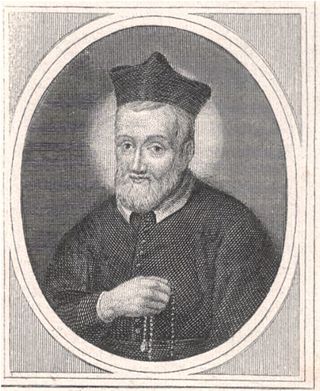
Antonio Grassi, born Vincenzo Grassi, was an Italian Roman Catholic priest and a professed member of the Oratorians. Grassi was known for his humble and pious nature with a strong devotion to the Marian devotions of Loreto to where he made pilgrimages on an annual basis.
The Biblioteca Laudense is the main public library located on Via Solferino #72, in the town of Lodi, in the region of Lombardy, Italy. The library is in the Palazzo San Filippo, once housing the convent and chapel of the Oratorians. It now houses the library and a Civic Museum of Lodi.
Pietro Augustoni was an Italian architect of the Rococo and Neoclassical period, mainly active in the Marche region of Italy, including Fermo, a region under the governance of the Papal States.
The Church of the Oratory or in Italian, Chiesa dell’Oratorio or Chiesa dei Padri Filippini is a Neoclassical-style Roman Catholic church located on Via San Rafaele #1 in Acireale, region of Sicily, Italy. The church is notable for artworks by Antonino Bonaccorsi, Paolo Leonardi Vigo, Francesco Mancini, and Alessandro Vasta. The church is still affiliated with the order which runs the nearby Istituto San Michele.

The churches of Verona are the places of Catholic worship that have been built within the administrative boundaries of the municipality of Verona, evidence of the ups and downs that the city has experienced throughout its history.














